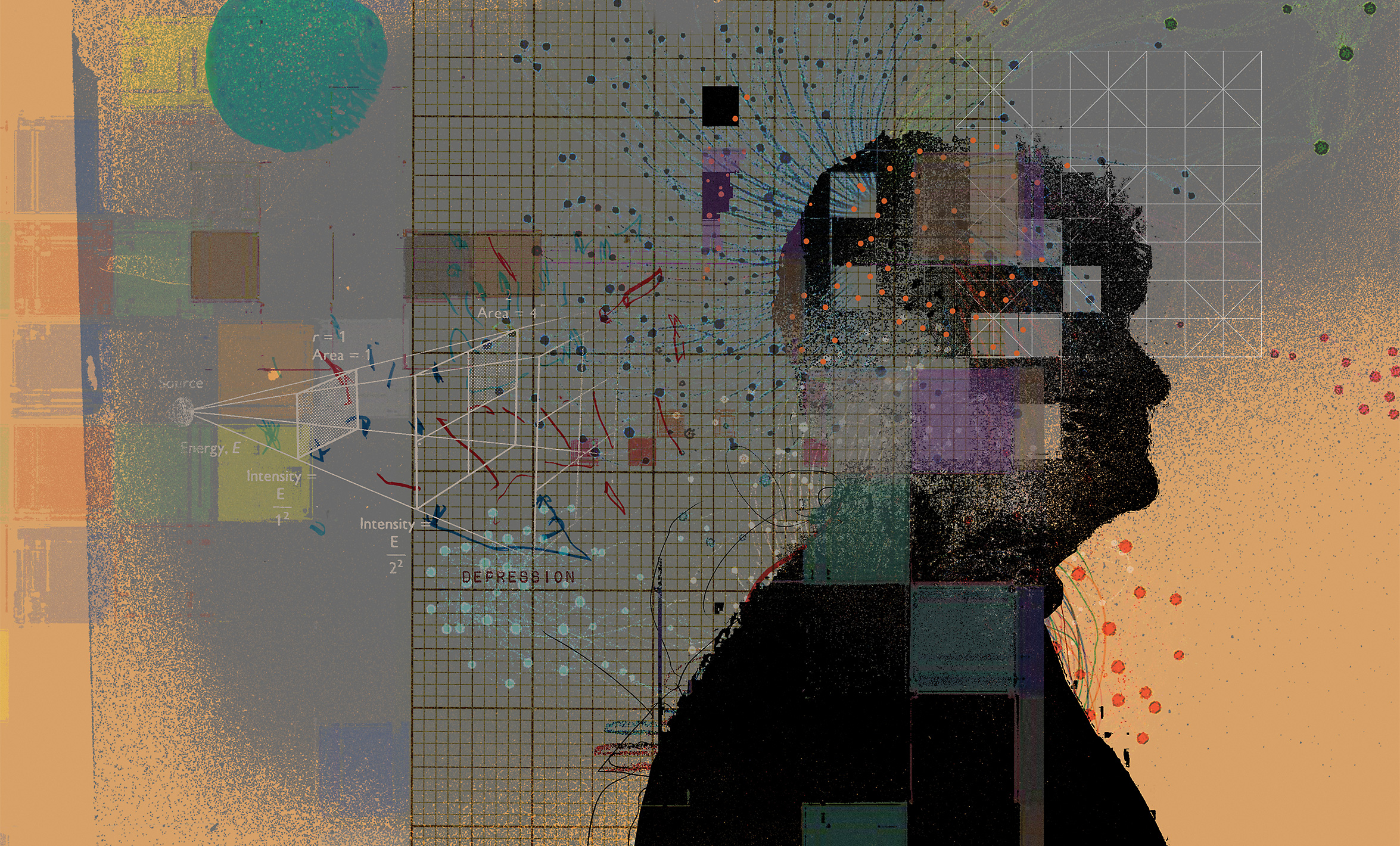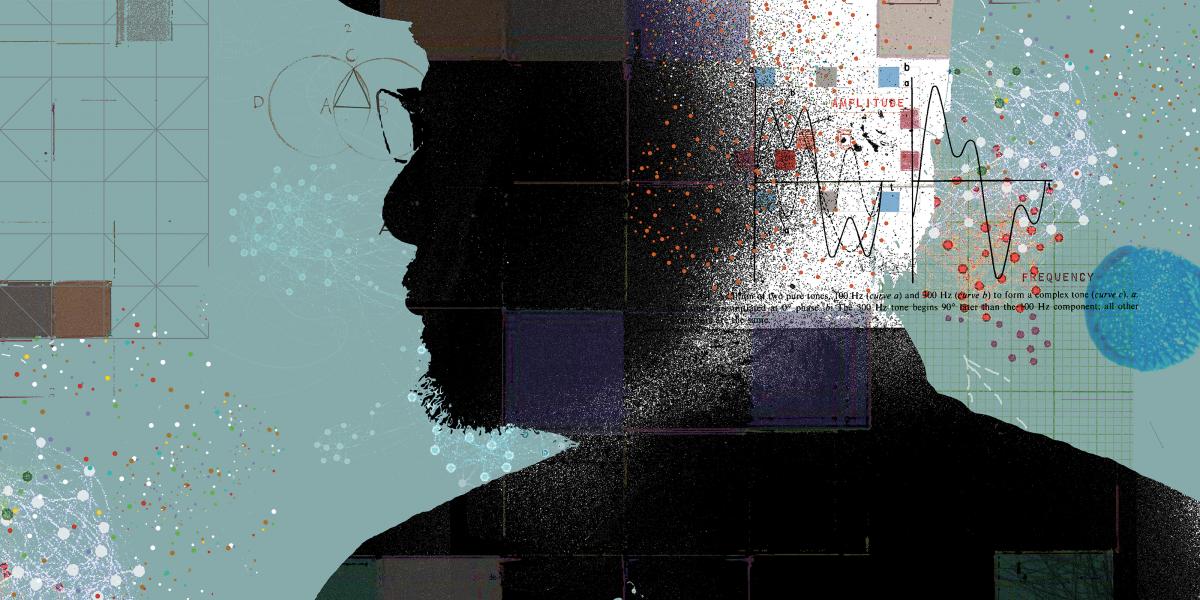New Cochlear Center Will Test Whether Treating Age-Related Hearing Loss Can Delay Dementia
Once considered an inconvenience of getting older, age-related hearing loss has emerged as a critical public health issue.
When Frank Lin, MD, PhD ’08, looks up from his desk, his eyes often fall upon President Donald Trump’s jagged signature. And that always makes him smile.
That signature is on a framed copy of the Over-the-Counter Hearing Aid Act that hangs on Lin’s office wall. An associate professor in Epidemiology and Mental Health at the Bloomberg School and of Otolaryngology and Medicine at the School of Medicine, Lin helped create the legislation, which the president signed into law last year. Lin’s copy also bears handwritten notes of appreciation to him from Senators Elizabeth Warren and Chuck Grassley, two of the five cosponsors of the bipartisan act, which designates a new category of hearing aids. Consumers with perceived mild to moderate hearing loss will be able to acquire these OTC hearing aids without seeing an audiologist, just as a self-diagnosed farsighted person can purchase a pair of reading glasses at a drugstore. The law gives the FDA three years to develop technical specifications to ensure the effectiveness and safety of the devices and to develop appropriate labeling to inform and protect consumers.
For Lin, the framed law serves as a tangible sign of success in his eight-year-and-counting effort to change how the field of public health addresses age-related hearing loss, which affects some 26 million Americans over age 50 and two-thirds of people over age 70. Untreated hearing loss is thought to contribute to dementia and cognitive decline, among other health problems, and can lead to social isolation and depression.
Lin is well-positioned to tackle the issue. As an otolaryngologist, he observed the negative impact hearing loss had on his patients’ daily functioning, and he began to wonder if he could address the problem on a grander scale. He interrupted his surgical residency to pursue a public health PhD in clinical investigation.
“If you step back and view the issue from a public health perspective, you realize no one has asked the most basic questions about the concept of hearing loss in older adults—how you address it, evidence for treatment, things like that,” Lin says. “So I brought a public health background to thinking about a clinical problem I saw all the time, as well as to complaints that no progress has been made—the rates of hearing aid use are no different today than they were 50 years ago, and hearing aids are so expensive.”
Working first with the President’s Council of Advisors on Science and Technology and then the National Academies of Science, Engineering and Medicine, Lin began developing what would become the Over-the-Counter Hearing Aid Act during the Obama administration. The law aims to address the troubling fact that only about 20 percent of those who could benefit from wearing a hearing aid have chosen to get one. Their high cost is a principle reason: Today, these regulated medical devices, which must be acquired from a licensed health professional, cost as much as $4,000 and are not covered by Medicare, Medicaid or most private insurers.
This law cut through Washington gridlock because conservatives applauded its free-market approach to cost reductions, and liberals supported increased access to the devices while providing regulatory oversight for consumer safety. “By D.C. standards, we got it passed pretty quickly,” Lin says of the act he hopes will shake up a moribund hearing aid industry and bring cheaper, better devices to market.
THE EAR-BRAIN CONNECTION
That he was able to unite lawmakers across the political aisle bodes well for Lin’s ability to bring together researchers from diverse disciplines—from audiology and neuroscience to health economics and epidemiology—around the overlooked topic. This effort got a boost in March with the opening of the Cochlear Center for Hearing and Public Health in the Department of Epidemiology to focus on hearing loss and aging. The Center was created with existing NIH grant funding and a $10 million gift from Cochlear Ltd., an Australian company that produces implantable hearing devices. Lin says he’d already been leading a “de facto Lin Research Group,” conducting epidemiological trials and community-based interventions, but the new funding from Cochlear Ltd. will support core infrastructure, such as hiring biostatisticians and boosting scholarship funding for the next generation of researchers.
Lin recognizes the contributions public health has made in understanding and battling childhood hearing loss and developing interventions to prevent hearing loss in noisy workplaces and other environments. Now he would like to see that same level of attention devoted to age-related hearing loss.
“I think for years and years it was seen as, ‘Well, it’s just grandma getting a little older,’” Lin says. “But we wanted to find out if the hearing loss we all develop to some degree was linked with more critical outcomes. What we started looking at was dementia, because arguably for the next 50 years dementia is the biggest problem facing public health.”
Research linking the two is surprisingly spotty, Lin says, with perhaps the best work being a 1989 case control study published in the Journal of the American Medical Association. The study did demonstrate an association between hearing impairment and dementia while lending support to the hypothesis that hearing impairment contributes to cognitive dysfunction in older adults. Such case control studies are usually followed up by more rigorous research, but with the exception of a few psychology-based studies, Lin says the potential connection had received little further study. So from 2010 to 2014, he led a series of epidemiological studies to explore a possible link. These studies revealed that hearing loss was associated with an increased risk of institutionalization and hospitalization, an increased risk for dementia and increased health care costs.
The new Center will build on this work. Lin is currently recruiting some 850 seniors for the Aging and Cognitive Health Evaluation in Elders (ACHIEVE) study, a three-year randomized control trial in which half of the participants will get hearing-loss care and the rest more generalized counseling on healthy aging. “We’ll see whether … if we treat hearing loss, we can, in fact, delay cognitive decline, delay dementia and reduce health care costs,” Lin says.
Current thinking suggests multiple ways untreated hearing loss can contribute to dementia. One of the more straightforward ways is through social isolation, as those who find it challenging to follow conversations and participate in group activities begin to keep to themselves, forgoing book club meetings or bingo nights, for example. Not only are such people at risk for depression, but the reduced stimulation may lead to brain atrophy—the “use it or lose it” theory of brain health.
Epidemiology Professor Emeritus Michel Ibrahim, MD, PhD, MPH, experienced this “withdrawing” phenomenon firsthand. He experienced hearing loss in his mid-50s, but before he fully acknowledged and understood his condition—which was ultimately successfully treated with a cochlear implant—he modified his behavior. “For a period of several years, I was afraid to engage in social occasions because I had a hard time following conversations in groups,” he says. “I really started isolating myself.”
What happens when someone has hearing loss is that the sound isn’t accurately encoded and the ear sends a garbled signal to the brain. And because the brain has to work harder to process the signal, we think that means there are fewer brain resources for other functions, such as making a memory.
The cognitive load theory offers another explanation for the connection between hearing loss and dementia, suggesting that the brain can be overworked by the demands of understanding poor aural input, to the detriment of other mental activities. “When sound goes in to the ear, it’s encoded into a signal that goes up to the brain where it’s decoded—into a word, for example,” explains Jennifer Anne Deal, PhD ’13, MHS ’07, an assistant scientist in Epidemiology and at the School of Medicine who studies aging and cognitive decline. “So, typically, what happens when someone has hearing loss is that the sound isn’t accurately encoded and the ear sends a garbled signal to the brain. And because the brain has to work harder to process the signal, we think that means there are fewer brain resources for other functions, such as making a memory.”

AMPLIFIED EFFORTS
In July 2017, The Lancet published the results of a literature review and meta-analysis of existing dementia research, focusing on examining nine modifiable risk factors for dementia. The results affirmed the efforts of Lin and his fellow researchers, as hearing loss was ranked the most potentially significant of the modifiable risk factors that also included diabetes, smoking, obesity and physical inactivity. This, of course, makes the OTC Hearing Aid Act all the more timely, with its goals of improving access and driving down hearing aid costs.
But there is more to getting folks to wear the devices than price. “When we look at other countries, like the United Kingdom, where hearing aids are covered through the National Health Service, the rates of use are higher than here, but they’re not that much higher,” says Carrie Nieman, MD, MPH, a core faculty member in the Cochlear Center and instructor in the Department of Otolaryngology-Head and Neck at Johns Hopkins Hospital. “So, affordability is part of it, but it’s not the whole story.”
Other reasons hearing aids are not worn by more older adults include a lack of awareness of how helpful they can be, the hassles of the multiple audiologist visits that can be required to acquire them, and the social stigma associated with wearing them. Low-income, minority seniors have some of the lowest rates of hearing aid use, which led Nieman and Lin to cofound Access HEARS in 2015, a Baltimore nonprofit organization providing affordable sound amplification devices to this population. They are also examining how the community-delivered care model might be utilized to increase access to hearing care. Essentially, they are trying to see how effective it is to teach members of a community how to teach others to use hearing technology.
"Through the Baltimore HEARS study, we’re training ...six community health workers for older adults who will be out there delivering the HEARS program to fellow residents in their buildings,” Nieman says. “Any device is not going to solve all of the issues. We will always need counseling and education alongside them.”
Meanwhile, decoupling the devices from mandated middlemen—hearing care professionals—allows manufacturers to sell directly to consumers, which Lin feels will entice tech giants like Apple, Samsung and Bose to enter the market.
“All of these tech companies now have these wearable hearing devices that pair with their phones, and the difference between any of those devices and a hearing aid is about six months in R&D,” Lin says. “These regulations would allow Apple to sell, say, an AirPod Plus with a hearing aid built in, and you can see how that changes things. People wear these devices routinely all the time.”
The FDA should complete its work developing specs for over-the-counter hearing aids in 2020, at which time tech firms can begin developing their devices. The ACHIEVE study will be complete a few years after that, hopefully showing that treating hearing loss can delay the onset of dementia in older adults. But even then, Lin and the new Cochlear Center will continue to advance hearing health.
“Over the next five to 10 years, the goal is projecting what we have been doing here, globally,” Lin says. “There are a lot of countries in the world where there’s literally no hearing care infrastructure in place and there’s no thought about hearing loss at all. The Center’s funding is really going to get us moving overseas, places like China and much of East Asia that are projected to have the biggest growth of older adults. We want to be building collaborations and training people there.”
The Cochlear Center for Hearing and Public Health is housed in the Department of Epidemiology.
